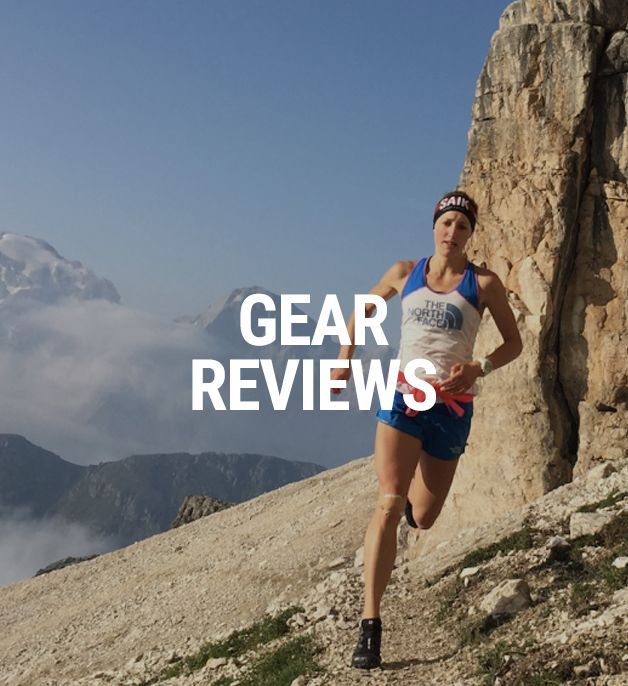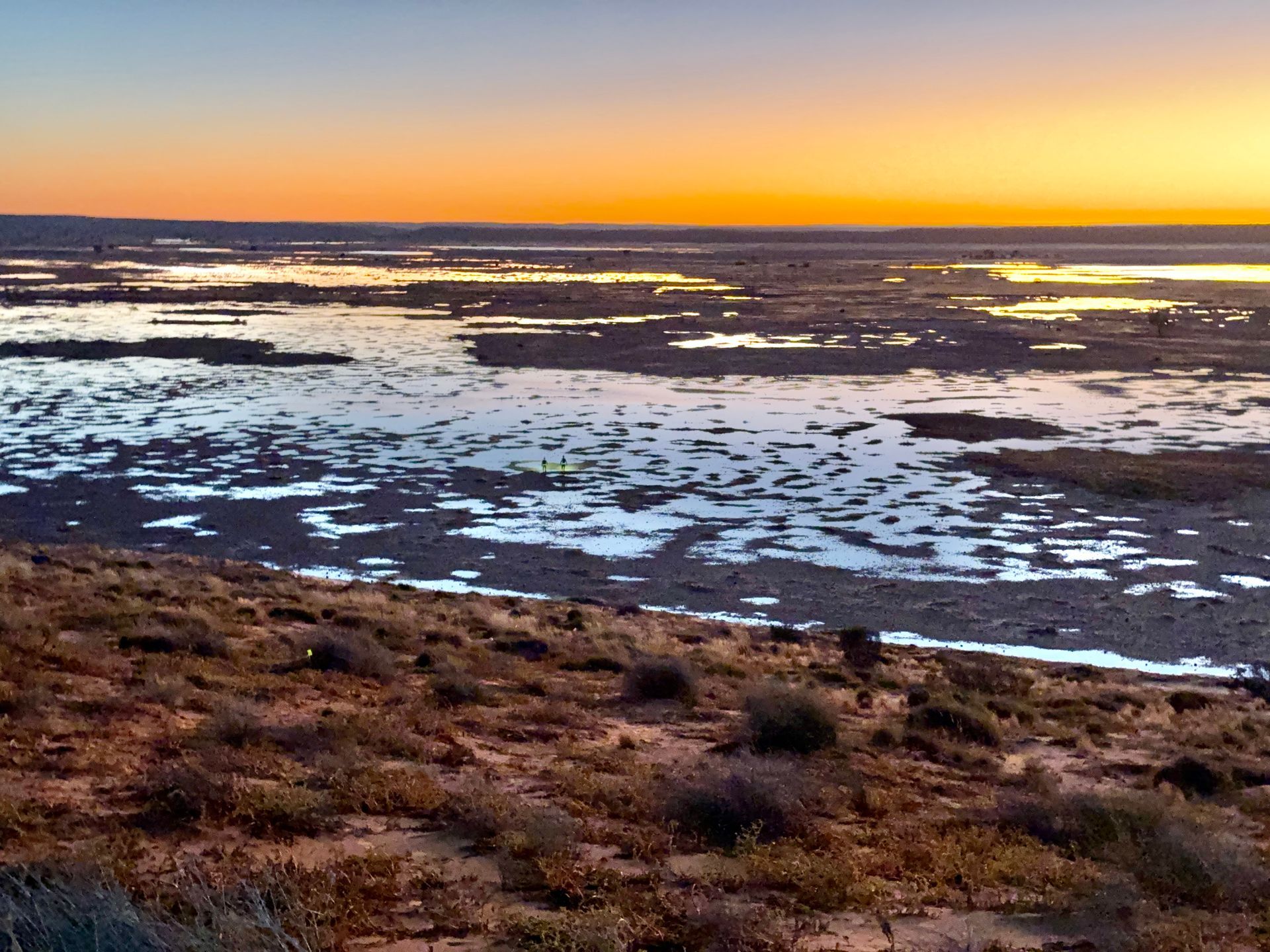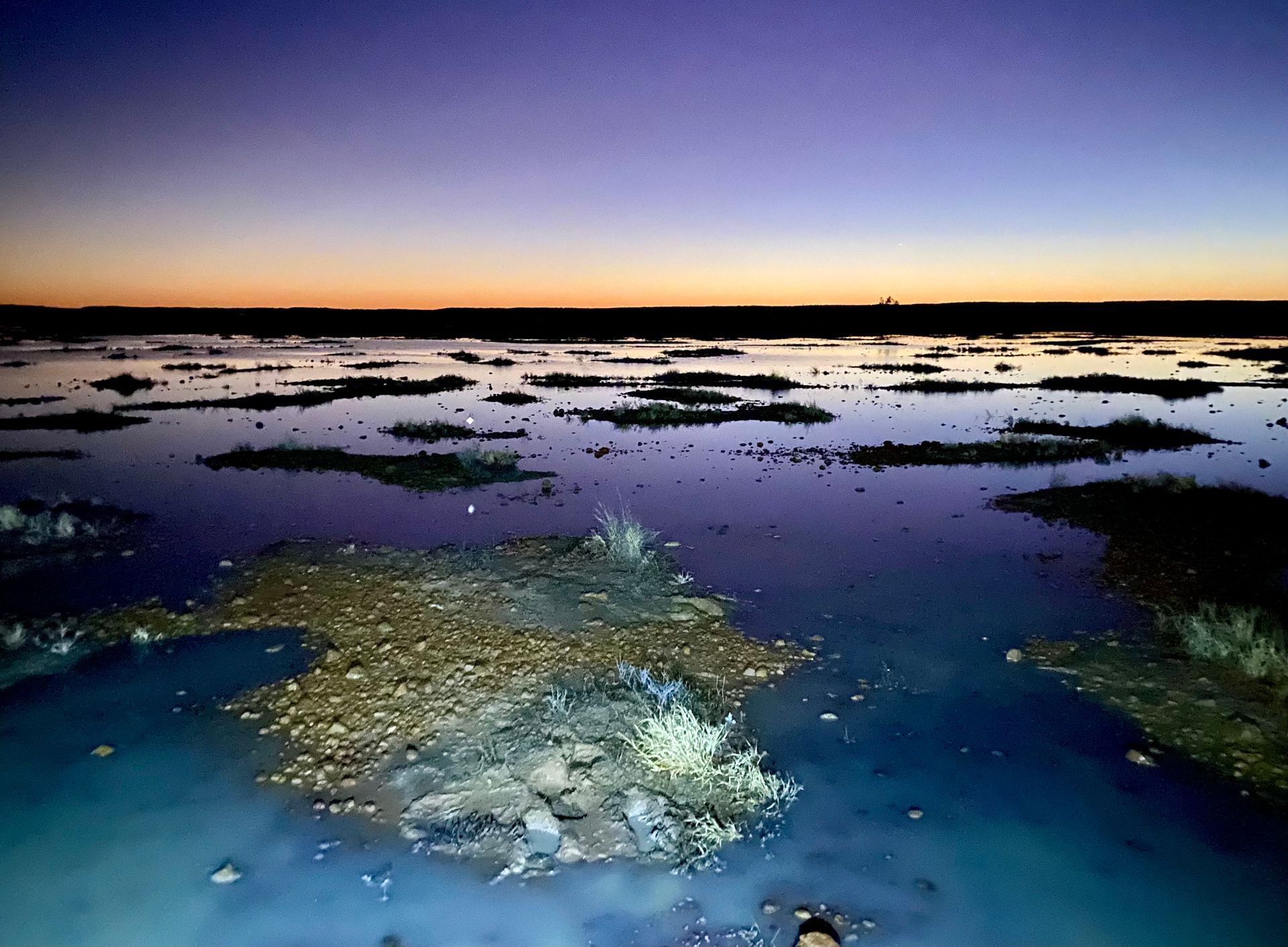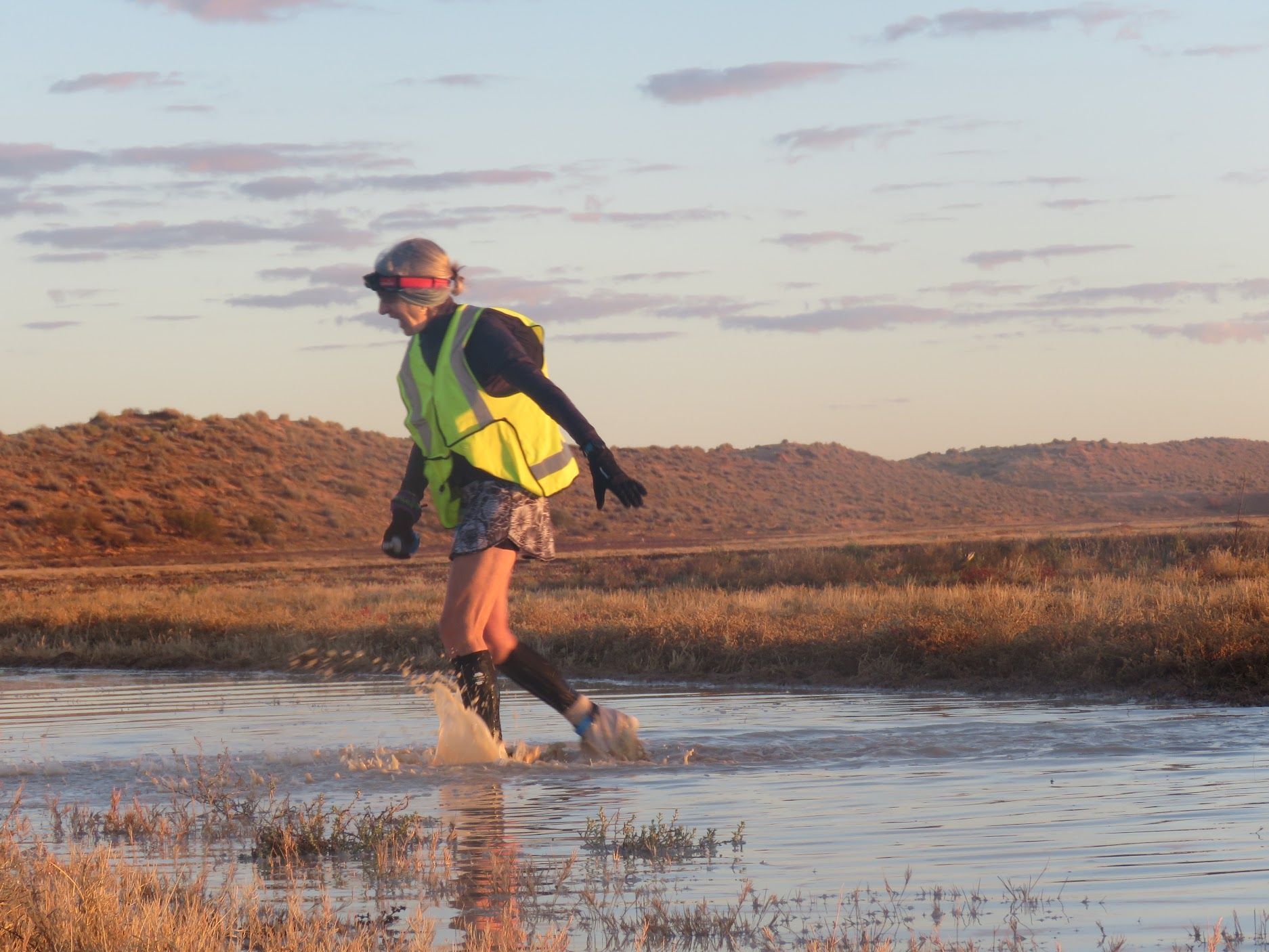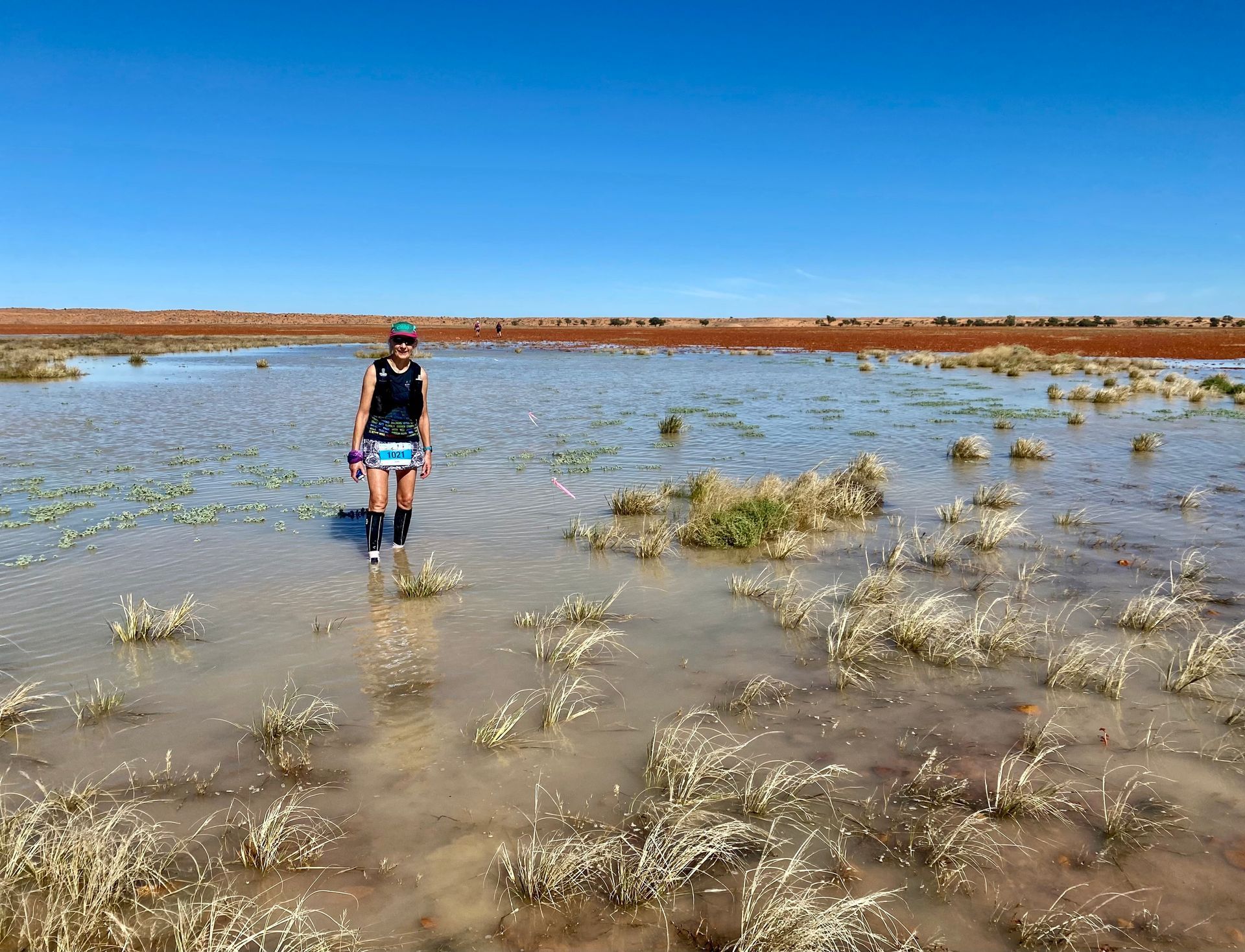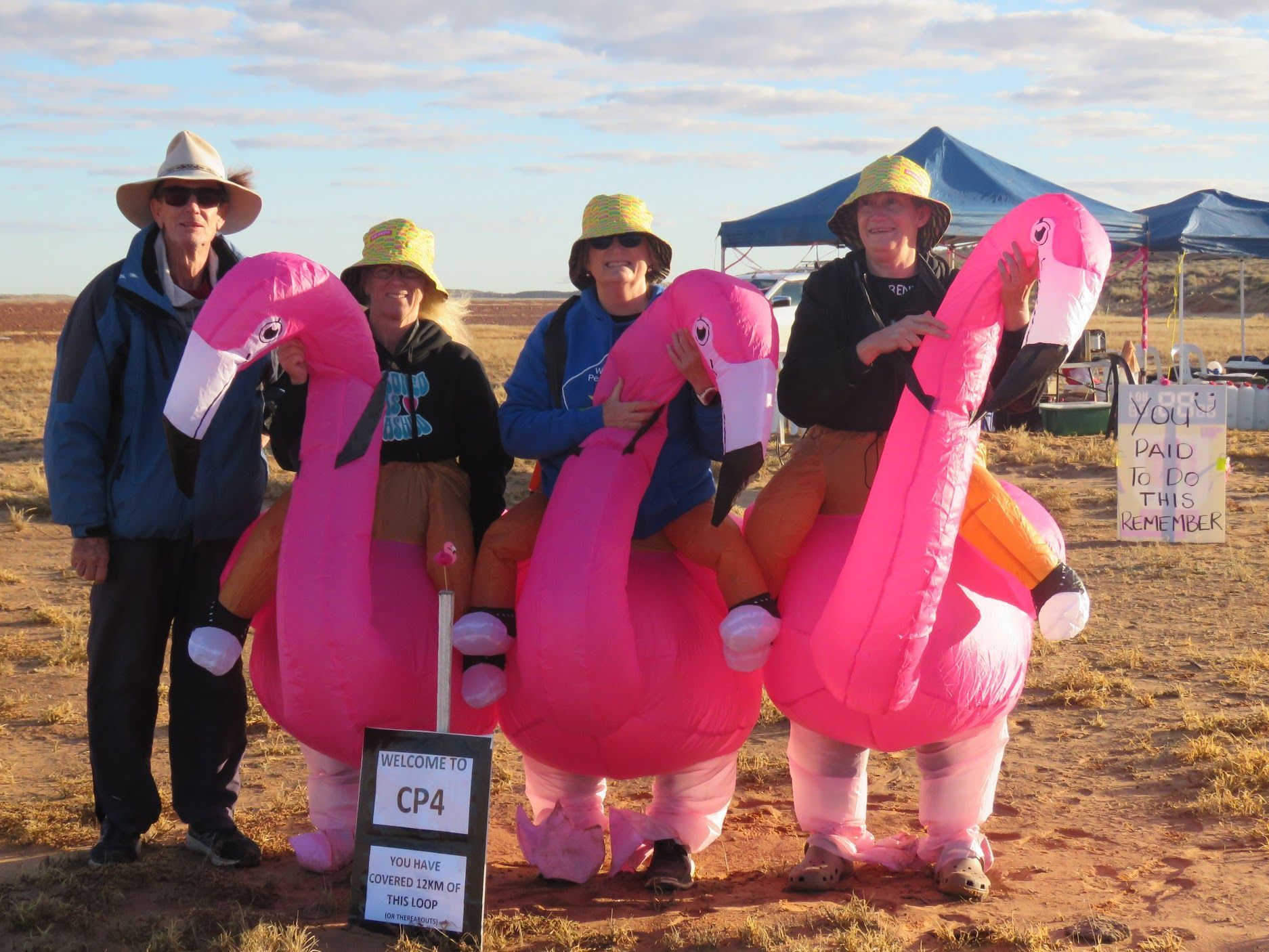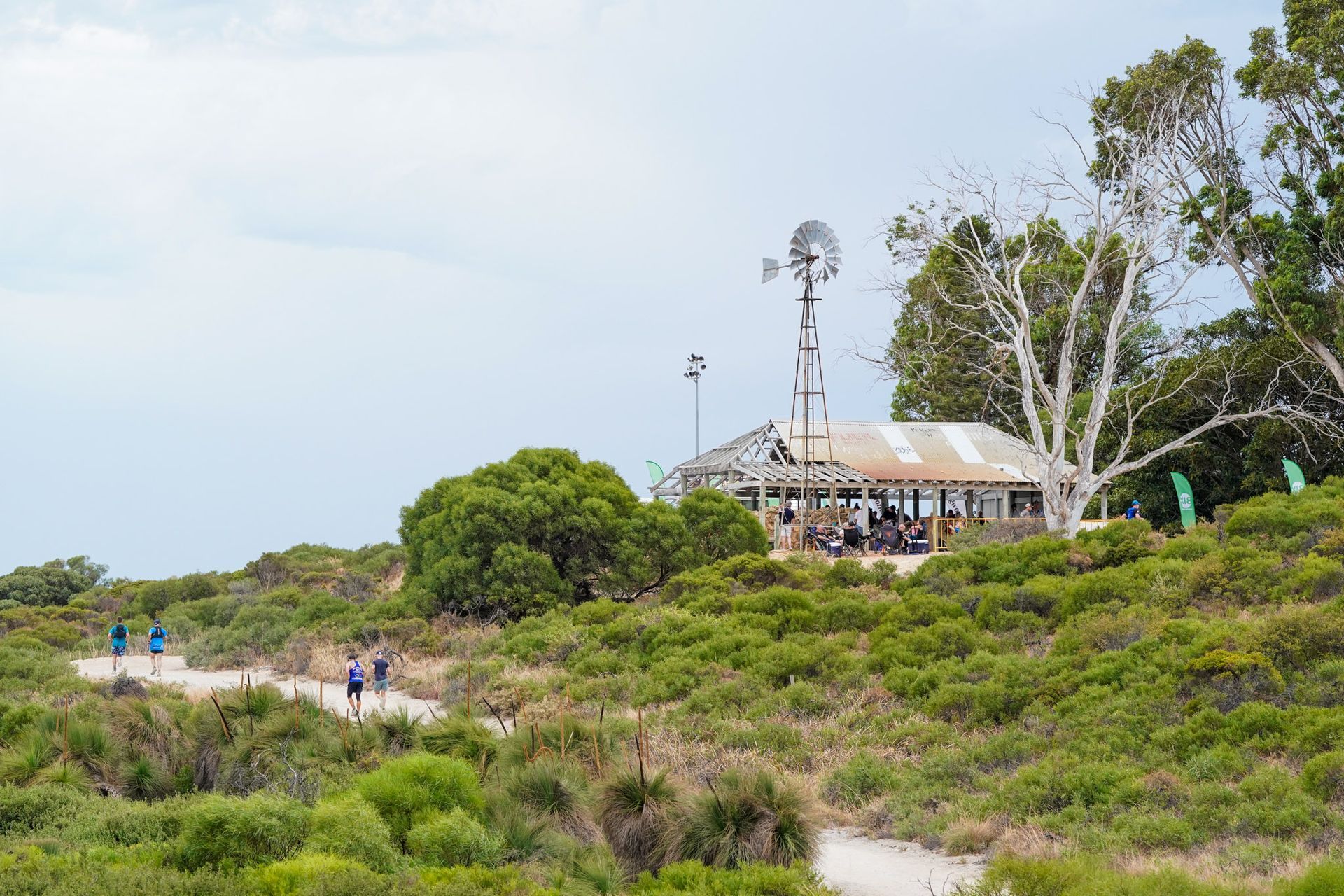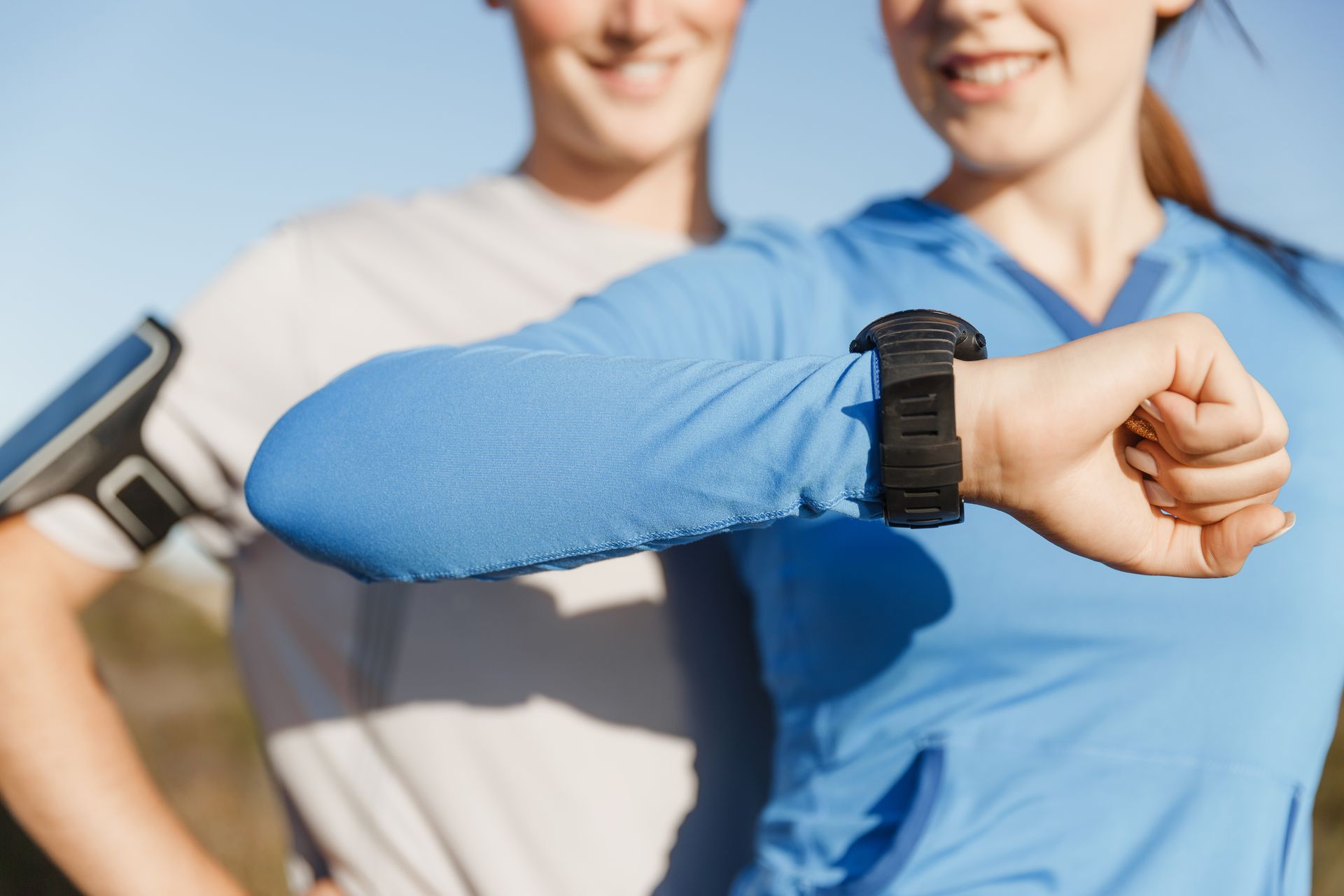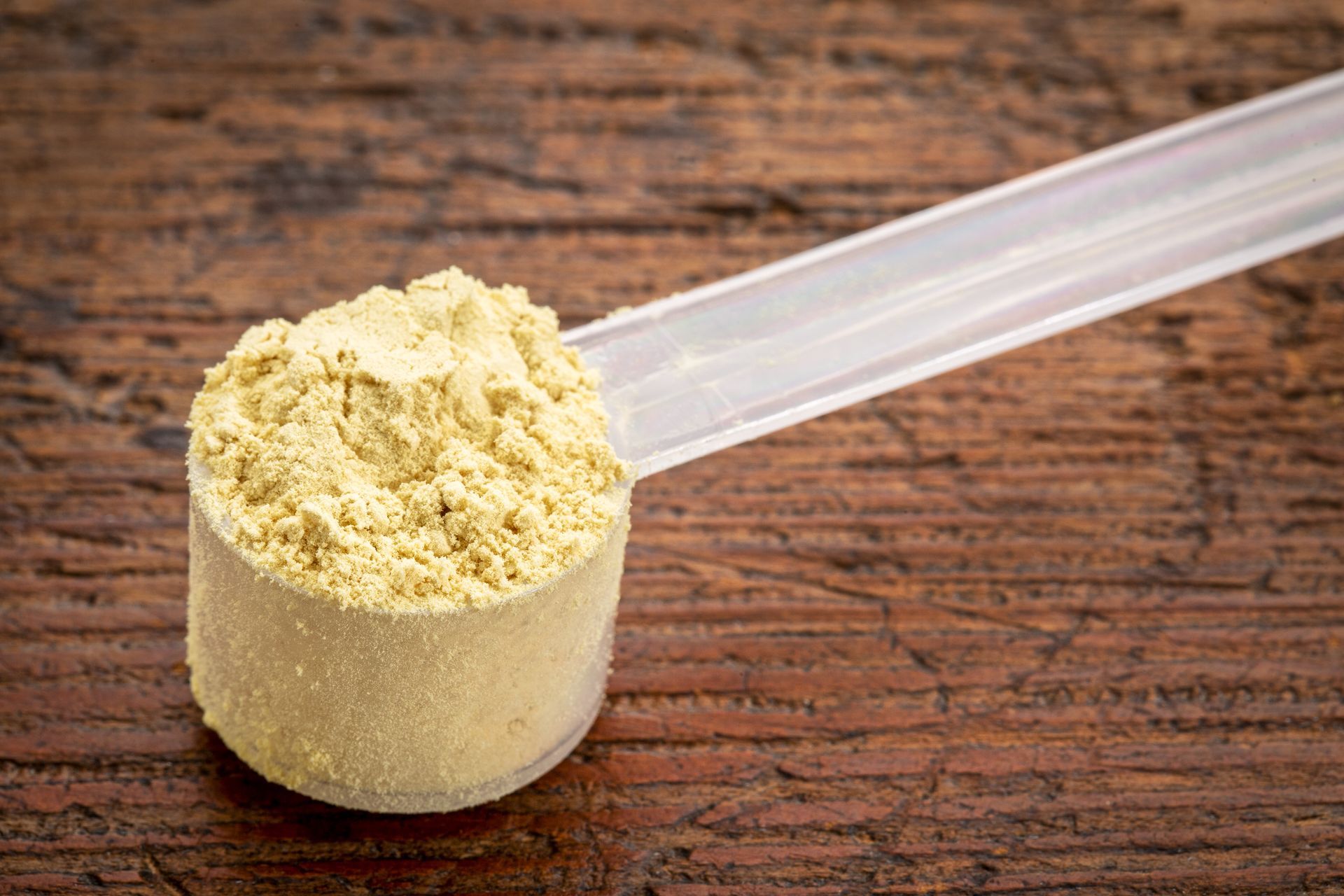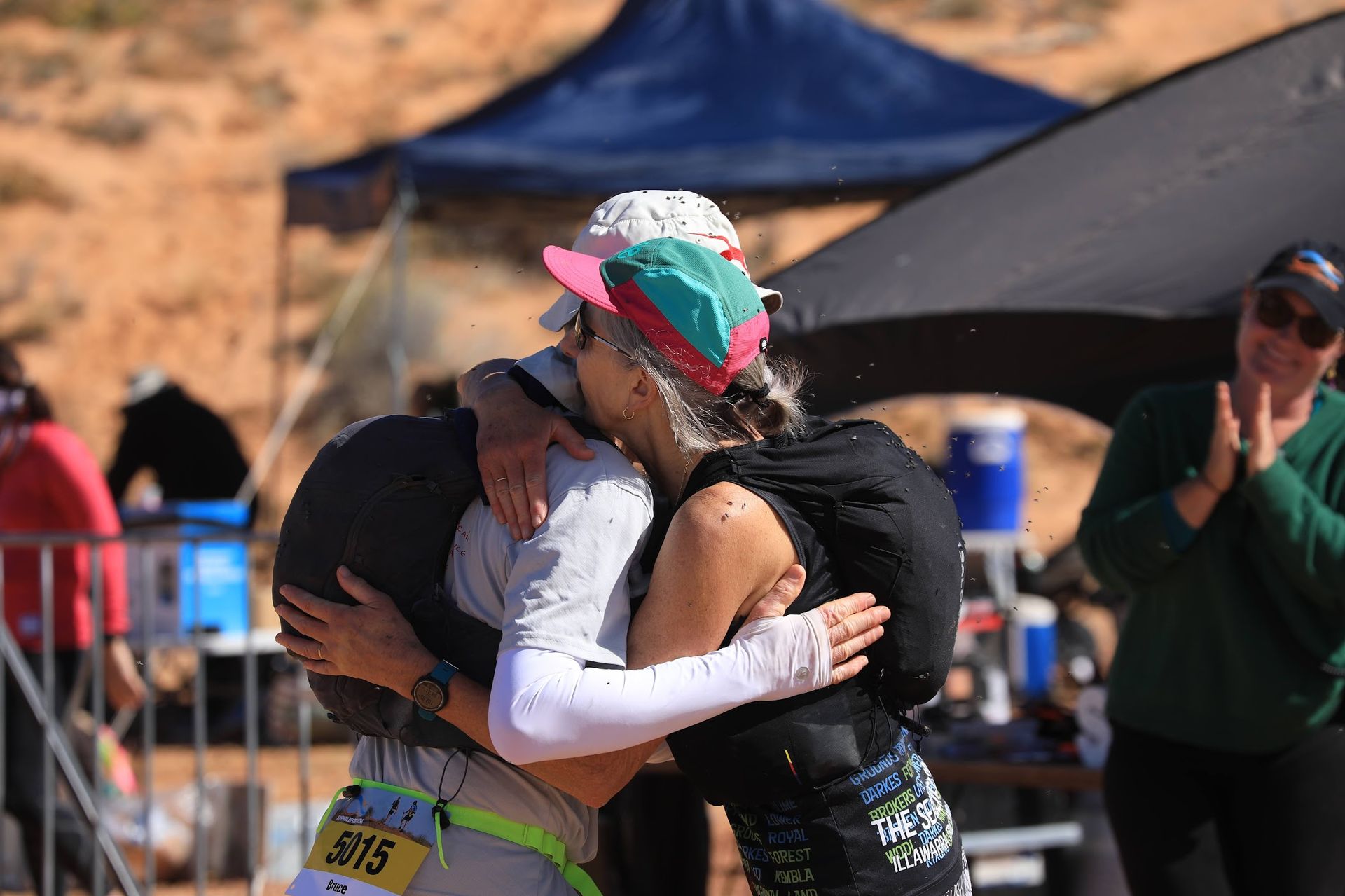
Race Report: Simpson Desert Ultra by Julie Steele
Simpson Desert Ultra
1 June 2024
Birdsville, qld
contributed by Julie Steele, aura member
The Simpson Desert Ultra (SDU) is a unique, epic personal adventure. Fun (aka race) director Jenna Brook conceived the notion in 2019 to provide an opportunity to immerse individuals in her stunning homeland's desert environment. Participants can choose to traverse 25km (starting at dusk or dawn), 50km, 75km, or 100km. In stark contrast to most commercially focused events, there is no race "winner", and individual performance times are recorded as participants enter and leave each checkpoint only to ensure no one is left aimlessly roaming through the vast desert.
Instead of glorifying podium placements, upon completing your journey, each participant is rewarded with a vibrant enamel mug hand-painted by local Indigenous women (best "medal" ever!). Participants select their own start time based on their predicted pace (walkers encouraged), constrained by reaching designated checkpoints by specified cutoffs (or else be extracted) and attempting to cross that elusive finish line in a similar time window to celebrate everyone's epic achievement together and facilitate magical finish line vibes.
The event takes place on Adria Downs Station, an enormous 8750-square-kilometre organic cattle station owned by David Brook (Jenna's father), encompassing iconic outback landmarks such as Big Red. The course, located ~25km west of Birdsville, consists of four 25km loops (North, South, West and East), fanning out like a four-leaf clover from a central hub, with fully stocked aid stations at checkpoints (CP) about halfway through each loop. Emergency CPs stocked with water, first aid supplies and radio contact are located at easy evacuation points twice each loop between the hub and main loop CP.
The central hub is party central - with a flaming bonfire, bopping music, and eagerly waiting support crews. Although radiating outwards in different directions, each loop contains common elements of fine red sand dunes, extensive gibber plains (think flat plains covered in ankle-breaking marbles and jagged stones of varying size), and clay pans punctuated with cow hoof-inflicted potholes. Unlike the arid, hot desert environment we experienced during the inaugural 2021 event, this year, extensive unseasonal rainfall in the preceding months had inundated the course, with flooding amplified by a torrential downpour the day before race registration. The soaking rains helped compact the fine sands into a somewhat runnable surface relative to 2021.
However, much of the course was substantially flooded, with panoramic views from dune tops looking more like a coastal reef than an inland desert. The water transformed the gibbers and clay pans into slippery quagmires or icy ankle-deep lakes hiding mystery objects beneath the opaque surfaces. Wading rather than running through the water was often the only option to minimise getting soaked from excessive splashing or twisting an ankle on hidden gibbers.
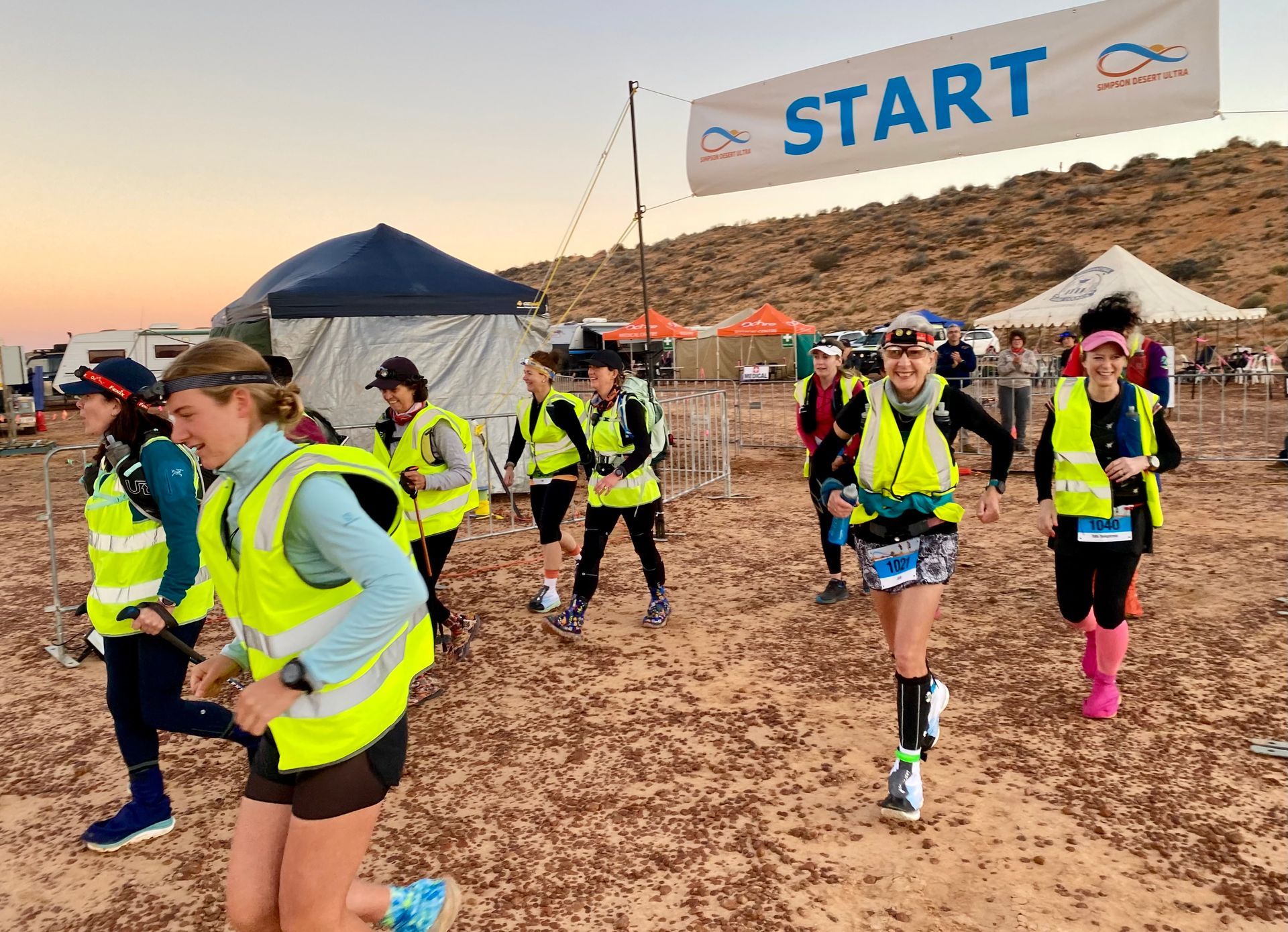
Images by calumn hockey, julie steele
Given the harsh conditions, I started my 100km adventure at 6pm, anticipating at least 18+ hours to complete the course, based on course knowledge gleaned during the inaugural SDU. Unlike 2021, when I ran the first lap predominantly alone, this year I was accompanied at the start by several others, all entering the first flooded plain as the desert sun was setting. I had the privilege of traversing most of the first (North) loop with SDU grand slammers (i.e., participated in all 4 SDU events), John and Lesly, who are renowned for "sliding" into Birdsville each year in their mighty sticker-clad 2WD Corolla.
Despite the challenging mud fest, Lesly set a cracking pace throughout the loop, dragging John and me along to complete the first lap in ~3 hours 35min. John and Lesly are also competing in UTMB for their third time later this year, so gaining some precious UTMB tips from them during our time in Birdsville was highly beneficial. My next three loops were at a much more leisurely pace (~ 5 hours each, including time in the hub and CPs) simply because of the increasing fatigue in those challenging g conditions!
Crossing into the hub after the first loop (~9.35pm), I stripped off my soggy shoes and socks to remove the pre-race toe tape now floating in my socks. It was pointless to reapply any tape on my wrinkly soaked feet, which would be immersed again in the infamous muddy, mid-calf deep channel ~20m after starting the next loop. Instead, I smothered them in Sudocrem to provide a token barrier to the moisture and hoped my untaped arthritic toes would survive the next 75km of abuse. I donned fresh merino socks but the same shoes, which would remain unchanged for the rest of the event because of the relentless wet conditions.
I left for the second South loop at ~10pm alone and remained by myself for much of the loop, enjoying the chance to savour the bright desert stars with the new moon yet to rise. The course was exceptionally well marked with highly reflective tags and vibrant pink ribbons, so navigating the terrain was relatively easy (unlike in 2021 when cows ate crucial markers, leading runners astray). It was easy until my headlamp had a catastrophic failure during the loop, and all went pitch black. Although I had a backup waist lamp, it was also failing, with the moon not yet offering any assistance.
Thankfully, I had a spare battery, which I fumbled with freezing fingers to insert into the headlamp, although it took several attempts to reset the correct lighting mode. To preserve a secondary backup battery until the hub, I switched off my waist light, which made navigating the uneven terrain much more difficult. It was extremely comforting to see ahead in the distance the flashing red lights attached to the packs of other participants, who had commenced their journey earlier in the afternoon. At least now, I would not be left stranded in the dark again if my new battery failed.
I kept counting the kilometres to the hub, where my power bank lay. My hands were bitterly cold after relentlessly splashing through the icy mud and water. A huge thanks to the young male CP2 volunteer who so kindly helped me force my frozen fingers into my gloves and filled my flasks so I could safely make it back to the central hub.
Images Supplied
Finally reaching the central hub (~3am), I grabbed my power bank to recharge my waist light during the next loop. After refilling my Tailwind flasks, scoffing some peaches, and putting on a fleece to cope with the cooling temperatures, I wandered out of the hub, munching on a small bag of Nutri-Grain®. It was now too cold to sit down or stop unless vital, so I refuelled by eating and drinking on the move to keep the blood circulating enough to stop my feet from turning into ice blocks. The third (West) loop was simply brutal. We spent much of the initial few kilometres of the loop wading through never-ending ankle-deep water. As far as my headlamp could illuminate, all I could see in every direction was opaque water rippling in the icy breeze.
Although common sense assured me that crocodiles don't migrate this far inland, a distant splashing noise convinced me a smiling croc somewhere in those extensive waters was stalking me. At least it motivated me to wade forward as swiftly as I could. Cruelly, the CP on this loop was 14 km away, rather than the 12.5 km midpoint, causing me to question whether I was on the correct course (thank goodness for Avenza Maps). I am sure I saw the elusive CP ~12km in and confirmed with another runner that the vision ahead must be the CP, or else we were both hallucinating – hmmm. Reaching that CP was pure bliss, especially when greeted with the warm smiles of the enthusiastic volunteers on such a chilly pre-dawn morning. Grabbing some Shapes and refilled flasks, I wandered off, counting the hours until sunrise and the desperate desire to feel warm sun rays. When it finally eventuated, the glorious sun rising over the red dunes is a memory that will forever be etched in my mind.
Entering the hub at the end of loop 3 (~8am), I quickly scoffed some more peaches, brushed my fury teeth (game changer), changed into a Seacliff Coasters singlet (although I kept on the fleece until it warmed up), and donned a peak cap in anticipation of warmer temperatures as the morning progressed. I briefly bumped into Bruce, who was leaving to start his second and final East loop of the 50km event, about 30 minutes ahead of me. After starting his run at midnight, 13km into his first loop, Bruce came across a woman lying on the ground, suffering a major medical episode, with one other participant graciously trying to render assistance.
After donating his emergency blanket, beanie and waterproof pants to keep the woman warm in the freezing pre-dawn cold, Bruce climbed the closest wind-whipped dune to get sufficient signal to implement the emergency protocol described in the SDU briefing notes. In possibly the most difficult-to-access location on the course, inaccessible by the 4WD ambulance, one of the Brook Proprietors personnel was called to skilfully navigate his way over the enormous dune in his pastoral 4WD (much to the amazement of onlookers) to transport the woman to the care of waiting ambulance personnel. The incident highlighted the crucial need for all participants to carry designated mandatory gear and to ensure they are familiar with emergency protocols. Given his shoes were too muddy to remove while waiting in the cold, Bruce creatively wrapped his thermal pants around his head to keep warm. Who said thermal pants weren't useful?
As I departed the hub, Jenna, with that trademark twinkle in her eyes, suggested I try to catch Bruce – a challenge I happily accepted. The goal motivated me to keep high stepping forward as fast as my exhausted legs would go. Implementing my regular latter-race shuffle was too dangerous because of the constant trip hazards. Instead, you had to consciously lift each foot above gibber height, which is hugely demanding on the quads. Despite screaming muscles, I caught Bruce about 5 km into the loop. Bruce and I have never had the opportunity to share the experience of running an ultra-event together. But with the unique SDU format, we could accompany each other for ~20 km of the final stages of this event. On relatively fresher legs, Bruce maintained his usual walk-run strategy.
In contrast, I attempted to keep high-stepping along, especially on the flatter gibber plains, only stopping to wade through the now churned-up water features and slide down the steep dune faces. Using these strategies, we reached the final CP, with the CP4 volunteers adorned in hot pink, partially deflated flamingos beside amusing signage ("It's a sand dune, get over it"). The final stages of the East loop involved crawling up a never-ending series of parallel sand dunes. At the peak of each dune, we were confronted with an expansive (i.e., a couple of kilometres) flooded gibber plain that we had to traverse before reaching yet another steep dune. During each climb, we silently prayed that at the peak, we would see the central hub and elusive finishing in the distance – only to be confronted by yet another gibber plain-sand dune combination with no hub in view (had they moved the hub?). Finally, after scaling about the sixth dune peak, we sighted the hub – thank goodness!
We had to traverse one more flooded gibber plain and wade through the notorious muddy channel to reach that elusive finish line together. Hearing the welcoming hollering from the hub and an exquisite finish-line hug from Bruce and Jenna nearly 19 hours after I commenced this epic journey (just before 1 pm) was brilliant. I had completed my SDU adventure with a smile (102 km with 1,081 m elevation gain– according to Strava) and gratefully received my mug.
Although I have participated in numerous ultras, I loved running in this smaller (~130 participants over all four distances) community-based event for pure enjoyment, motivated solely by the individual challenge of completing the adventure however I wished. Motivation was not dictated by "beating others", performance was not tracked on the internet, and the completion times are unlikely to be documented publicly – okay, maybe individual performances will creep onto Strava. The lack of emphasis on performances creates a much more inclusive and relaxing atmosphere, particularly when anyone struggling at a set distance could finish one of the other options.

Image by calumn hockey
The logistics associated with hosting an ultra in such a remote location are hard to fathom, particularly when unseasonal rain events like this year impact the event. All roads leading into Birdsville were closed on Thursday night after torrential rain, leaving numerous participants stranded on the roadside in remote outback Queensland. However, communication from the SDU team about the conditions was superb, with the roads opening at the last minute but with sufficient time for most trusting participants to make it to the delayed start. Successfully implementing such a unique event takes a whole village.
I can't thank the "village chief" (aka Fun Director), Jenna, enough for conceiving and implementing to perfection this unique notion. Participating in the SDU has genuinely changed our lives. We hired that loud Bear Rentals 4WD adorned with a tiny rooftop tent to travel to the inaugural event back in 2021. We loved the experience so much that we invested in a camping setup, which we lovingly use to attend ultras around the country and to return to Birdsville for this final SDU. There are not many events that I would drive over 5,000 km to attend (although that included our treasured outback adventures along the way).
Thank you also to the Brook family, who allowed this unique event to be hosted on such scenic land and for your unwavering support for Jenna and her team. I also extend a huge thank you to Jacqui Parker (Dream Enabler) and the massive number of volunteers who provided the backbone to this event. And to the whole Birdsville community – including the local Indigenous women who painted those mugs – you made all of us feel so welcome in your fabulous outback town. I am deeply grateful to everyone who made the SDU dream a reality, including Bruce and our fellow adventurers. I strongly encourage anyone who has not ventured to Birdsville to do so (the Bakery hot chocolates and curry camel pies are alone enough reason to travel that far).
Bruce and I also thank bush poet Harry Bestwick, aka Old Grumpy, whom we met sitting around a campfire at The Lake (just outside Quilpie). Harry was somewhat astonished when we mentioned that we were on our way to run through the Simpson Desert. To our surprise and delight, Harry penned a poem (that we will cherish) based on our brief encounter, which he later emailed to Bruce. It read:
Two young folk in their sixties
...we met up at The Lake
We must wonder at their sanity
for they run for running sake.
They've bought themselves a Trayon
and are heading out to Birdsville
Ultra marathons are their passion
through the Simpson Desert sandhill.
She's planning on a hundred k's
he's looking to do fifty
They both look like they're up for it
and are looking pretty nifty.
I'm told it's just for fun they run
just to meet up for a party
I raise my hat and wish them well
...I'd be drinking long and hearty.
- Old Grumpy, Harry Bestwick
The SDU is taking a hiatus in 2025 to give the enormous team of volunteers a chance to rest. Will it come back in 2026 or beyond? Even Jenna does not know. So … if you ever get a chance to run an event out this way, embrace the opportunity – it will likely change your life, too.
Again, thanks, SDU. Next stop, UTMB!

IMAGE BY CALUMN HOCKEY



